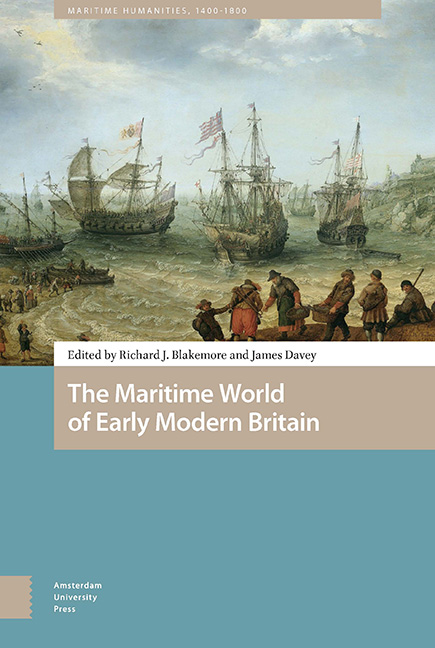Book contents
- Frontmatter
- Contents
- List of illustartions
- Acknowledgements
- Note on Conventions and Terminology
- Introduction
- 1 The Minion and Its Travels: Sailing to Guinea in the Sixteenth Century
- 2 Commanding the World Itself : Sir Walter Ralegh, La Popelinière, and the Huguenot Influence on Early English Sea Power
- 3 An Investigation of the Size and Geographical Distribution of the English, Welsh, and Channel Islands Merchant Fleet: A Case Study of 1571–72
- 4 An Evaluation of Scottish Trade with Iberia during the Anglo-Spanish War, 1585-1604
- 5 Performing ‘Water’ Ralegh : The Cultural Politics of Sea Captains in Late Elizabethan and Jacobean Drama
- 6 ‘Wicked Actions Merit Fearful Judgments’ : Capital Trials aboard the Early East India Company Voyages
- 7 A water bawdy house’: Women and the Navy in the British Civil Wars
- 8 ‘Thy sceptre to a trident change / And straight , unruly seas thou canst command’: Contemporary Representations of King Charles I and the Ship Money Fleets within the Cultural Imagination of Caroline England
- 9 ‘Proud Symbols of the Prospering Rural Seamen’ : Scottish Church Ship Models and the Shipmaster’s Societies of North East Scotland in the Late 17th Century
- 10 Systematizing the Sea : Knowledge, Power and Maritime Sovereignty in Late Seventeenth-Century Science
- Select Bibliography
- About the Contributors
- Index
1 - The Minion and Its Travels: Sailing to Guinea in the Sixteenth Century
Published online by Cambridge University Press: 21 November 2020
- Frontmatter
- Contents
- List of illustartions
- Acknowledgements
- Note on Conventions and Terminology
- Introduction
- 1 The Minion and Its Travels: Sailing to Guinea in the Sixteenth Century
- 2 Commanding the World Itself : Sir Walter Ralegh, La Popelinière, and the Huguenot Influence on Early English Sea Power
- 3 An Investigation of the Size and Geographical Distribution of the English, Welsh, and Channel Islands Merchant Fleet: A Case Study of 1571–72
- 4 An Evaluation of Scottish Trade with Iberia during the Anglo-Spanish War, 1585-1604
- 5 Performing ‘Water’ Ralegh : The Cultural Politics of Sea Captains in Late Elizabethan and Jacobean Drama
- 6 ‘Wicked Actions Merit Fearful Judgments’ : Capital Trials aboard the Early East India Company Voyages
- 7 A water bawdy house’: Women and the Navy in the British Civil Wars
- 8 ‘Thy sceptre to a trident change / And straight , unruly seas thou canst command’: Contemporary Representations of King Charles I and the Ship Money Fleets within the Cultural Imagination of Caroline England
- 9 ‘Proud Symbols of the Prospering Rural Seamen’ : Scottish Church Ship Models and the Shipmaster’s Societies of North East Scotland in the Late 17th Century
- 10 Systematizing the Sea : Knowledge, Power and Maritime Sovereignty in Late Seventeenth-Century Science
- Select Bibliography
- About the Contributors
- Index
Summary
The Minion was a ship of the Royal Navy, originally built in 1522, and named after the type of small cannon made of cast-iron or bronze frequently in use on Tudor and Stuart ships. Known as one of Henry VIII's favourites, referred to as ‘la Mignone’ by the French, ‘Mjinhona’ by the Portuguese, and ‘Minona’ by the Spanish, the Minion was rebuilt twice in the 1530s and included in an illustrated inventory of Henry's navy in 1546. Deployed initially in domestic and cross-Channel service, and involved in several skirmishes in Scottish, Irish, and European waters, it was later chosen as one of a small number of ships leased from the crown by London's overseas merchants in the 1550s and 1560s, when it was first used in the trade with Spain and, probably, the Canaries and/or the Azores, and later undertook travel to Africa and the West Indies on at least five separate occasions. Its last known voyage took the ship from the Caribbean to Cornwall, where it landed in Mount's Bay on 25 January 1569. Having already been the subject of complaints about its lack of deep-seaworthiness in 1561, it was condemned shortly after that final voyage, possibly in 1570, giving it a total lifespan of just under 50 years.
The Minion was neither the largest, nor the most widely travelled, nor the most famous ship in Tudor England. Instead it shares the characteristics of a range of other, hardly very remarkable vessels, which together formed the material base for the ‘maritime world of early modern Britain’ that is the subject of this volume. It is precisely its relative ordinariness, however, that makes it a particularly fitting example for the purposes of this essay. Taking my cue from recent explorations of ‘global microhistory’ as a theoretical model that integrates a focus on the local within a macro context, a close study of the Minion opens up a window on the master narrative of Britain's rise to a major sea power which allows local and individual stories to confirm or contest that explanatory framework. As we shall see, while the ship's move from domestic to European to global spheres of action signals a trajectory broadly compatible with the standard account of contemporary English maritime aspirations, the specific details of the Minion's travels reveal instead a series of unexpected historical alignments and social configurations.
- Type
- Chapter
- Information
- Maritime World of Early Modern Britain , pp. 37 - 66Publisher: Amsterdam University PressPrint publication year: 2020



